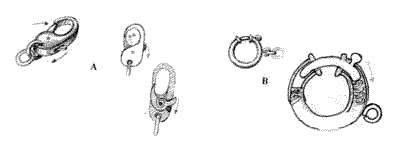|
|||||||||||||||||||||||||
|
|||||||||||
|
A keg closing
This closing is used for small objects and is built in two parts, a female part that is a cylinder with an entrance hole that has the diameter narrower than the inside one (dis. A), and a male part composed of a tongue like a "V" with a half round shape,it is made in white gold because this metal is more elastic than others. A part is attached to the cylinder and the other, a bit shorter, has a cock's comb that you press to |
|||||||||||
 |
|||||||||||
|
start the meccanism (dis. B-C) on the half round part of the tongue in the narrowest part of the female cylinder there's a stop of the closing. The click of the meccanism is precise so you can rely on it. A good thing to do is to sometimes add on the sides an "eight"of security
|
|||||||||||
|
A box closing with a lever
This type of closing is used for bracelets and necklaces,and can be of different sizes. There are two parts, one consists in a box (dis A.) that has the function of holding the tongue (dis. B), this has a square or a rectangular shape on the outside ,and another part that consists in a "V" lateral section (dis. C), the entrance hole is |
|||||||||||
 |
|||||||||||
|
rectangular with a square placed on the centre top of the tongue (dis. A). This will have the function of a stop to the of the opening once the spring of the tongue is released inside the box
|
|||||||||||
|
A spring clip and a spring ring closing
These are used for small and light objects. They usually open easily if they are used in their most resistant parts. The spring clip is an oval hook (dis. A) (fastener) with a rectilinear line that moves like a spring . The spring ring is a round (clasp, fastener) hook with a tubular part that has the form of a "C" that has a spring in it that pushes out of the tube a hinge to complete the closing of the circle (dis. B). |
|||||||||||
 |
|||||||||||
|
A bayonet closing
The bayonet closing has a cylinder shape and two elements, one has a "T" (dis. A) that will be fitted in the other element (dis. B) that has a hole and an internal spring that will resist to the "T". Once it's inserted in the hole it will make half a turn so it can be blocked (dis. C-D). For the variants of this technique (dis. E-F-G). |
|||||||||||
 |
|||||||||||